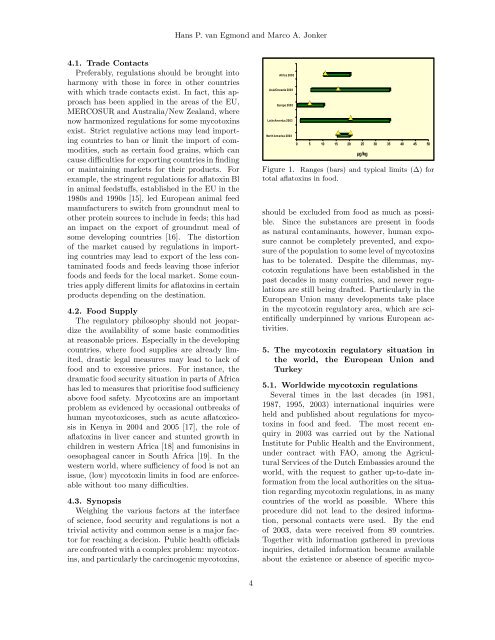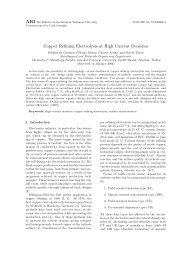Regulations for Mycotoxins in Food: Focus on the European ... - ARI
Regulations for Mycotoxins in Food: Focus on the European ... - ARI
Regulations for Mycotoxins in Food: Focus on the European ... - ARI
You also want an ePaper? Increase the reach of your titles
YUMPU automatically turns print PDFs into web optimized ePapers that Google loves.
4.1. Trade C<strong>on</strong>tacts<br />
Preferably, regulati<strong>on</strong>s should be brought <str<strong>on</strong>g>in</str<strong>on</strong>g>to<br />
harm<strong>on</strong>y with those <str<strong>on</strong>g>in</str<strong>on</strong>g> <str<strong>on</strong>g>for</str<strong>on</strong>g>ce <str<strong>on</strong>g>in</str<strong>on</strong>g> o<strong>the</strong>r countries<br />
with which trade c<strong>on</strong>tacts exist. In fact, this approach<br />
has been applied <str<strong>on</strong>g>in</str<strong>on</strong>g> <strong>the</strong> areas of <strong>the</strong> EU,<br />
MERCOSUR and Australia/New Zealand, where<br />
now harm<strong>on</strong>ized regulati<strong>on</strong>s <str<strong>on</strong>g>for</str<strong>on</strong>g> some mycotox<str<strong>on</strong>g>in</str<strong>on</strong>g>s<br />
exist. Strict regulative acti<strong>on</strong>s may lead import<str<strong>on</strong>g>in</str<strong>on</strong>g>g<br />
countries to ban or limit <strong>the</strong> import of commodities,<br />
such as certa<str<strong>on</strong>g>in</str<strong>on</strong>g> food gra<str<strong>on</strong>g>in</str<strong>on</strong>g>s, which can<br />
cause difficulties <str<strong>on</strong>g>for</str<strong>on</strong>g> export<str<strong>on</strong>g>in</str<strong>on</strong>g>g countries <str<strong>on</strong>g>in</str<strong>on</strong>g> f<str<strong>on</strong>g>in</str<strong>on</strong>g>d<str<strong>on</strong>g>in</str<strong>on</strong>g>g<br />
or ma<str<strong>on</strong>g>in</str<strong>on</strong>g>ta<str<strong>on</strong>g>in</str<strong>on</strong>g><str<strong>on</strong>g>in</str<strong>on</strong>g>g markets <str<strong>on</strong>g>for</str<strong>on</strong>g> <strong>the</strong>ir products. For<br />
example, <strong>the</strong> str<str<strong>on</strong>g>in</str<strong>on</strong>g>gent regulati<strong>on</strong>s <str<strong>on</strong>g>for</str<strong>on</strong>g> aflatox<str<strong>on</strong>g>in</str<strong>on</strong>g> Bl<br />
<str<strong>on</strong>g>in</str<strong>on</strong>g> animal feedstuffs, established <str<strong>on</strong>g>in</str<strong>on</strong>g> <strong>the</strong> EU <str<strong>on</strong>g>in</str<strong>on</strong>g> <strong>the</strong><br />
1980s and 1990s [15], led <strong>European</strong> animal feed<br />
manufacturers to switch from groundnut meal to<br />
o<strong>the</strong>r prote<str<strong>on</strong>g>in</str<strong>on</strong>g> sources to <str<strong>on</strong>g>in</str<strong>on</strong>g>clude <str<strong>on</strong>g>in</str<strong>on</strong>g> feeds; this had<br />
an impact <strong>on</strong> <strong>the</strong> export of groundnut meal of<br />
some develop<str<strong>on</strong>g>in</str<strong>on</strong>g>g countries [16]. The distorti<strong>on</strong><br />
of <strong>the</strong> market caused by regulati<strong>on</strong>s <str<strong>on</strong>g>in</str<strong>on</strong>g> import<str<strong>on</strong>g>in</str<strong>on</strong>g>g<br />
countries may lead to export of <strong>the</strong> less c<strong>on</strong>tam<str<strong>on</strong>g>in</str<strong>on</strong>g>ated<br />
foods and feeds leav<str<strong>on</strong>g>in</str<strong>on</strong>g>g those <str<strong>on</strong>g>in</str<strong>on</strong>g>ferior<br />
foods and feeds <str<strong>on</strong>g>for</str<strong>on</strong>g> <strong>the</strong> local market. Some countries<br />
apply different limits <str<strong>on</strong>g>for</str<strong>on</strong>g> aflatox<str<strong>on</strong>g>in</str<strong>on</strong>g>s <str<strong>on</strong>g>in</str<strong>on</strong>g> certa<str<strong>on</strong>g>in</str<strong>on</strong>g><br />
products depend<str<strong>on</strong>g>in</str<strong>on</strong>g>g <strong>on</strong> <strong>the</strong> dest<str<strong>on</strong>g>in</str<strong>on</strong>g>ati<strong>on</strong>.<br />
4.2. <str<strong>on</strong>g>Food</str<strong>on</strong>g> Supply<br />
The regulatory philosophy should not jeopardize<br />
<strong>the</strong> availability of some basic commodities<br />
at reas<strong>on</strong>able prices. Especially <str<strong>on</strong>g>in</str<strong>on</strong>g> <strong>the</strong> develop<str<strong>on</strong>g>in</str<strong>on</strong>g>g<br />
countries, where food supplies are already limited,<br />
drastic legal measures may lead to lack of<br />
food and to excessive prices. For <str<strong>on</strong>g>in</str<strong>on</strong>g>stance, <strong>the</strong><br />
dramatic food security situati<strong>on</strong> <str<strong>on</strong>g>in</str<strong>on</strong>g> parts of Africa<br />
has led to measures that prioritise food sufficiency<br />
above food safety. <str<strong>on</strong>g>Mycotox<str<strong>on</strong>g>in</str<strong>on</strong>g>s</str<strong>on</strong>g> are an important<br />
problem as evidenced by occasi<strong>on</strong>al outbreaks of<br />
human mycotoxicoses, such as acute aflatoxicosis<br />
<str<strong>on</strong>g>in</str<strong>on</strong>g> Kenya <str<strong>on</strong>g>in</str<strong>on</strong>g> 2004 and 2005 [17], <strong>the</strong> role of<br />
aflatox<str<strong>on</strong>g>in</str<strong>on</strong>g>s <str<strong>on</strong>g>in</str<strong>on</strong>g> liver cancer and stunted growth <str<strong>on</strong>g>in</str<strong>on</strong>g><br />
children <str<strong>on</strong>g>in</str<strong>on</strong>g> western Africa [18] and fum<strong>on</strong>is<str<strong>on</strong>g>in</str<strong>on</strong>g>s <str<strong>on</strong>g>in</str<strong>on</strong>g><br />
oesophageal cancer <str<strong>on</strong>g>in</str<strong>on</strong>g> South Africa [19]. In <strong>the</strong><br />
western world, where sufficiency of food is not an<br />
issue, (low) mycotox<str<strong>on</strong>g>in</str<strong>on</strong>g> limits <str<strong>on</strong>g>in</str<strong>on</strong>g> food are en<str<strong>on</strong>g>for</str<strong>on</strong>g>ceable<br />
without too many difficulties.<br />
4.3. Synopsis<br />
Weigh<str<strong>on</strong>g>in</str<strong>on</strong>g>g <strong>the</strong> various factors at <strong>the</strong> <str<strong>on</strong>g>in</str<strong>on</strong>g>terface<br />
of science, food security and regulati<strong>on</strong>s is not a<br />
trivial activity and comm<strong>on</strong> sense is a major factor<br />
<str<strong>on</strong>g>for</str<strong>on</strong>g> reach<str<strong>on</strong>g>in</str<strong>on</strong>g>g a decisi<strong>on</strong>. Public health officials<br />
are c<strong>on</strong>fr<strong>on</strong>ted with a complex problem: mycotox<str<strong>on</strong>g>in</str<strong>on</strong>g>s,<br />
and particularly <strong>the</strong> carc<str<strong>on</strong>g>in</str<strong>on</strong>g>ogenic mycotox<str<strong>on</strong>g>in</str<strong>on</strong>g>s,<br />
Hans P. van Egm<strong>on</strong>d and Marco A. J<strong>on</strong>ker<br />
4<br />
Africa 2003<br />
Asia/Oceania 2003<br />
Europe 2003<br />
Lat<str<strong>on</strong>g>in</str<strong>on</strong>g> America 2003<br />
North America 2003<br />
0 5 10 15 20 25 30 35 40 45 50<br />
!g/kg<br />
Figure 1. Ranges (bars) and typical limits (∆) <str<strong>on</strong>g>for</str<strong>on</strong>g><br />
total aflatox<str<strong>on</strong>g>in</str<strong>on</strong>g>s <str<strong>on</strong>g>in</str<strong>on</strong>g> food.<br />
should be excluded from food as much as possible.<br />
S<str<strong>on</strong>g>in</str<strong>on</strong>g>ce <strong>the</strong> substances are present <str<strong>on</strong>g>in</str<strong>on</strong>g> foods<br />
as natural c<strong>on</strong>tam<str<strong>on</strong>g>in</str<strong>on</strong>g>ants, however, human exposure<br />
cannot be completely prevented, and exposure<br />
of <strong>the</strong> populati<strong>on</strong> to some level of mycotox<str<strong>on</strong>g>in</str<strong>on</strong>g>s<br />
has to be tolerated. Despite <strong>the</strong> dilemmas, mycotox<str<strong>on</strong>g>in</str<strong>on</strong>g><br />
regulati<strong>on</strong>s have been established <str<strong>on</strong>g>in</str<strong>on</strong>g> <strong>the</strong><br />
past decades <str<strong>on</strong>g>in</str<strong>on</strong>g> many countries, and newer regulati<strong>on</strong>s<br />
are still be<str<strong>on</strong>g>in</str<strong>on</strong>g>g drafted. Particularly <str<strong>on</strong>g>in</str<strong>on</strong>g> <strong>the</strong><br />
<strong>European</strong> Uni<strong>on</strong> many developments take place<br />
<str<strong>on</strong>g>in</str<strong>on</strong>g> <strong>the</strong> mycotox<str<strong>on</strong>g>in</str<strong>on</strong>g> regulatory area, which are scientifically<br />
underp<str<strong>on</strong>g>in</str<strong>on</strong>g>ned by various <strong>European</strong> activities.<br />
5. The mycotox<str<strong>on</strong>g>in</str<strong>on</strong>g> regulatory situati<strong>on</strong> <str<strong>on</strong>g>in</str<strong>on</strong>g><br />
<strong>the</strong> world, <strong>the</strong> <strong>European</strong> Uni<strong>on</strong> and<br />
Turkey<br />
5.1. Worldwide mycotox<str<strong>on</strong>g>in</str<strong>on</strong>g> regulati<strong>on</strong>s<br />
Several times <str<strong>on</strong>g>in</str<strong>on</strong>g> <strong>the</strong> last decades (<str<strong>on</strong>g>in</str<strong>on</strong>g> 1981,<br />
1987, 1995, 2003) <str<strong>on</strong>g>in</str<strong>on</strong>g>ternati<strong>on</strong>al <str<strong>on</strong>g>in</str<strong>on</strong>g>quiries were<br />
held and published about regulati<strong>on</strong>s <str<strong>on</strong>g>for</str<strong>on</strong>g> mycotox<str<strong>on</strong>g>in</str<strong>on</strong>g>s<br />
<str<strong>on</strong>g>in</str<strong>on</strong>g> food and feed. The most recent enquiry<br />
<str<strong>on</strong>g>in</str<strong>on</strong>g> 2003 was carried out by <strong>the</strong> Nati<strong>on</strong>al<br />
Institute <str<strong>on</strong>g>for</str<strong>on</strong>g> Public Health and <strong>the</strong> Envir<strong>on</strong>ment,<br />
under c<strong>on</strong>tract with FAO, am<strong>on</strong>g <strong>the</strong> Agricultural<br />
Services of <strong>the</strong> Dutch Embassies around <strong>the</strong><br />
world, with <strong>the</strong> request to ga<strong>the</strong>r up-to-date <str<strong>on</strong>g>in</str<strong>on</strong>g><str<strong>on</strong>g>for</str<strong>on</strong>g>mati<strong>on</strong><br />
from <strong>the</strong> local authorities <strong>on</strong> <strong>the</strong> situati<strong>on</strong><br />
regard<str<strong>on</strong>g>in</str<strong>on</strong>g>g mycotox<str<strong>on</strong>g>in</str<strong>on</strong>g> regulati<strong>on</strong>s, <str<strong>on</strong>g>in</str<strong>on</strong>g> as many<br />
countries of <strong>the</strong> world as possible. Where this<br />
procedure did not lead to <strong>the</strong> desired <str<strong>on</strong>g>in</str<strong>on</strong>g><str<strong>on</strong>g>for</str<strong>on</strong>g>mati<strong>on</strong>,<br />
pers<strong>on</strong>al c<strong>on</strong>tacts were used. By <strong>the</strong> end<br />
of 2003, data were received from 89 countries.<br />
Toge<strong>the</strong>r with <str<strong>on</strong>g>in</str<strong>on</strong>g><str<strong>on</strong>g>for</str<strong>on</strong>g>mati<strong>on</strong> ga<strong>the</strong>red <str<strong>on</strong>g>in</str<strong>on</strong>g> previous<br />
<str<strong>on</strong>g>in</str<strong>on</strong>g>quiries, detailed <str<strong>on</strong>g>in</str<strong>on</strong>g><str<strong>on</strong>g>for</str<strong>on</strong>g>mati<strong>on</strong> became available<br />
about <strong>the</strong> existence or absence of specific myco-



